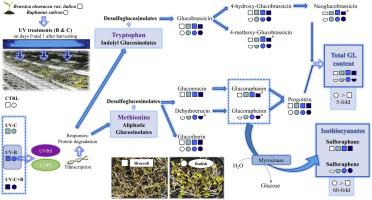Postharvest Biology and Technology ( IF 6.4 ) Pub Date : 2021-07-24 , DOI: 10.1016/j.postharvbio.2021.111650 Lorena Martínez-Zamora 1 , Noelia Castillejo 1 , Francisco Artés-Hernández 1

|
The objective of this study was to evaluate the effect of UV lighting (UV-B, UV-C and UV-C + UV-B) as a postharvest abiotic stress in the quality changes of minimally processed Brassicaceae sprouts (broccoli and radish) during a shelf-life period of 10 d at 4 °C. No UV illumination was used as control (CTRL). The total UV-C doses received were 9 kJ m−2 (UVC) and 15 kJ m−2 UV-B (UVB) by applying the 50 % of such doses after harvest and on the first day of the shelf-life. Results showed that when UVC was applied, the epiphytic microbial load was reduced up to 1 log CFU g-1 fw. The UVB treatment reported the highest total phenolic content (TPC) and total antioxidant capacity (TAC) after 10 d at 4 °C. In general, both species showed an amelioration effect in the TPC and TAC after UV treatments, which also enhanced the glucosinolate (GL) and the main isothiocyanates (ITC) content. In fact, UVB increased by ∼30 % the GL content compared to CTRL samples, which were mostly aliphatic GLs in radish and indolyl GLs in broccoli. As main ITC, sulforaphane content was enhanced by 37.5 % in UVB-treated broccoli sprouts while the sulforaphene content was highly increased by 72 % in radish sprouts. In conclusion, UVB radish sprouts reported 5-fold higher GL content and 60-fold higher biologically ITC content than broccoli sprouts. Therefore, its inclusion in the daily intake is recommended to increase the prevention of chronic inflammatory diseases.
中文翻译:

收获后 UV-B 和 UV-C 辐射增强了十字花科芽菜中硫代葡萄糖苷和异硫氰酸酯的生物合成
本研究的目的是评估紫外线照明(UV-B、UV-C 和 UV-C + UV-B)作为采后非生物胁迫对最低限度加工的十字花科芽(西兰花和萝卜)质量变化的影响。 4°C 下的保质期为 10 天。没有使用紫外线照明作为对照 (CTRL)。通过在收获后和保质期的第一天应用 50% 的此类剂量,接收到的总 UV-C 剂量为 9 kJ m -2 (UVC) 和 15 kJ m -2 UV-B (UVB)。结果表明,当应用 UVC 时,附生微生物负荷降低至 1 log CFU g -1转发 UVB 处理在 4°C 下 10 天后报告了最高的总酚含量 (TPC) 和总抗氧化能力 (TAC)。总的来说,两种物种在紫外线处理后都显示出 TPC 和 TAC 的改善效果,这也提高了硫代葡萄糖苷 (GL) 和主要异硫氰酸酯 (ITC) 的含量。事实上,与 CTRL 样品相比,UVB 增加了约 30% 的 GL 含量,CTRL 样品主要是萝卜中的脂肪族 GL 和西兰花中的吲哚基 GL。作为主要的 ITC,经过 UVB 处理的西兰花芽中萝卜硫素含量增加了 37.5%,而萝卜芽中萝卜硫素含量增加了 72%。总之,UVB 萝卜芽的 GL 含量比西兰花芽高 5 倍,生物 ITC 含量高 60 倍。所以,











































 京公网安备 11010802027423号
京公网安备 11010802027423号